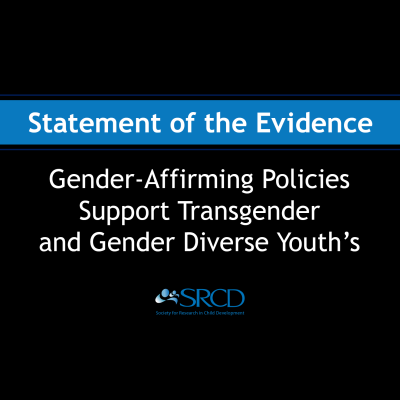Addressing Inequities in Education: Considerations for Latinx Children and Youth in the Era of COVID-19
Edited by Tiffany Yip, Ph.D., Fordham University. For more information, contact Kelly R. Fisher, Ph.D., Director for Policy, or Nighisti Dawit, M.Sc., Senior Policy Associate, Society for Research in Child Development, at policy@srcd.org.
Authors
- Lisa M. López, Ph.D., University of South Florida
- R. Gabriela Barajas-Gonzalez, Ph.D., New York University
- Guadalupe Díaz, Ph.D., Sobrato Early Academic Language Model
- Franklin Moreno, M.A., University of California, Berkeley
- Cynthia García Coll, Ph.D., University of Puerto Rico
Latinx populations are disproportionately impacted by COVID-19. Prevention efforts, including shelter-inplace, place an additional burden on Latinx populations due to existing socio-economic, mental health, and educational inequities. Reflecting these inequities, Latinx families are disproportionately low-income, have lower levels of education, limited knowledge of the United States’ educational system, lack access to technology, and struggle reading English. They may be unable to help children with schoolwork, and thus, school closures are more detrimental for them. Latinx families disproportionately represent the essential workforce increasing their odds of becoming infected by COVID-19. Latinx children’s anxiety for their family’s safety and well-being is fueled by fear of losing their parents to deportation. Schools serving Latinx children must prioritize all necessary safety considerations for staff, teachers, and children upon reopening. Schools must provide children with high quality dual language education, special education services, and increased mental health services with specific emphasis on trauma-informed care and resilience building.
COVID-19 has exacerbated existing socio-economic, mental health, and educational inequities that disproportionately affect Latinx families in the U.S, with serious consequences for their children.1 Many children have to be left unsupervised while parents work essential jobs in high-risk conditions.2 Barriers due to immigration status, segregation into low-resourced schools, English-only educational policies, and limited access to social services restrict Latinx families’ socio-economic mobility, exacerbating learning gaps, and leading to increased risks of anxiety for children.3
Socioeconomic Barriers Place Latinx Families at Increased Risk
Latinx parents make up a significant portion of the essential workforce,4-8 84% cannot telework,2,9 and are overrepresented in industries at the epicenter of COVID-19 outbreaks: meatpacking and poultry processing plants (34% Latinx);10-14 and agriculture (80% Latinx).6,15-16 Furthermore, to preserve economic resources, many live in crowded, multigenerational homes17 or rent rooms in their homes to others,18 increasing risks of spreading the virus. Nationally, Centers for Disease Control and Prevention data indicate Latinx people ages 40-59 have been infected at rates five times that of non-Hispanic white people in the same age group.16 Latinx children are being diagnosed at higher rates with multisystem inflammatory syndrome, a serious disease linked to COVID-19.19 As many families have limited access to health care, are excluded from governmental support, or avoid medical treatment for fear of Immigration and Customs Enforcement (ICE) arrests, the risk of serious complications of COVID-19 are exacerbated.20 “The government is telling them, it needs them to go to work, but it hasn’t halted deportations.”15
Latinx Children and Families Experience Chronic Stressors
Latinx children and youth are disproportionately exposed to trauma and stress grounded in marginalization, poverty, racism, and immigration status,21,22 and assume greater responsibilities in their households,23 placing them at risk for anxiety and depression. Although 94% are U.S. citizens,24 they are twice as likely to live in poverty as non-Hispanic white children.21 Latinx families report higher food insecurity than the national average, > which has been exacerbated by school closings.25
Latinx families are also disproportionately impacted by policing and deportations26,27 since one-quarter of parents are considered > unauthorized immigrants.24 Children’s anxiety increases with this chronic uncertainty about their own safety and the fear of losing their parents.28-31 Moreover, parents’ fears about jeopardizing chances of obtaining legal status, due to restrictive changes in policies, such as the public charge rule,32 discourage Latinx families from applying for public benefits for which they are eligible, further increasing food insecurity.33-35 Due to these chronic stressors, Latinx households may not have the systemic supports to buffer children from the health, developmental, and educational consequences of COVID-19.36,37
Educational Barriers for Latinx Families Exacerbate Learning and Language Gaps
Latinx children are experiencing profound language, social, and academic losses because of school closures and the implementation of distance learning.2 Twenty-seven percent of students in U.S. schools are Latinx, speaking mostly Spanish at home.38 Latinx caregivers have lower levels of education, may have limited knowledge of the U.S. educational system,39 may struggle reading English,40 and are unable to help children with their schoolwork. In North Carolina, the Forsyth County Latino Congress stated, “Spanish-speaking parents are struggling to help their children learn during the pandemic because they have limited familiarity with technology and little understanding of schoolwork in English.”41
English Learners (ELs; 75% of whom are Latinx in K-12 schools; 62% in Early Care and Education (ECE) Programs) face increased educational disparities.42-44 Many ELs lack access to stable internet at home, limiting their ability to engage in distance learning programs and activities.2,45 Teachers more often feel unprepared to teach ELs46 and are less likely to receive professional development on using digital learning resources for instructing ELs.45 Low-income Latinx children are segregated into low-resource schools and communities39 and families are excluded from participating in discourse concerning educational reform,47 constraining their access to critical educational resources. Caregivers rely on schools to provide critical services to children with special needs. Many have lost access to reading, speech, behavior, physical, and occupational therapies - further widening the achievement gap.2 School closures have disproportionately impacted Latinx families who rely on schools and ECE programs to access nutritious meals, and opportunities for social, language, and cognitive growth.48, 49
Policy and Practice Implications
Latinx children often endure chronic stressors and educational barriers that are exacerbated by the pandemic. This confluence of factors may have detrimental effects on Latinx children’s ability to cope and learn now and in the future.2 When addressing the impact that COVID-19 has on Latinx children and families, educational leaders should work with federal and state representatives to allocate funding to implement the following recommendations:
- Address the challenges that virtual education approaches can pose specifically for English Learners (even when there is full access to technology), by opening schools serving Latinx children for in-person learning as soon as health and safety requirements can be met. Take steps such as facilitating access to personal protective equipment (PPE) to minimize COVID-19 transmission, prioritizing sanitation, maintaining low student-teacher ratios, providing sufficient materials for individual student access, and offering flexible work and attendance options.2,50
- Allocate funding to ensure Latinx children have access to stable high-speed internet and necessary technology.
- Schools should provide explicit training on high quality in-person and online learning instructional practices to support Latinx children’s language and academic needs.
- Implement and expand dual language education and support students’ oral language development to overcome inequities due to limited educational resources during COVID-19.51
- Ensure that teachers/staff proactively assess Latinx students’ and families’ technology access and support, English language support, and socio-emotional needs via regular online or phone check-ins, as they may be reluctant to seek help.
- Employ bilingual/bicultural social workers, school psychologists, and guidance counselors at the National Association of Social Workers recommended ratios of 1:50.52
- Provide evidence-based, culturally and linguistically appropriate, trauma-informed school-based mental health services for students and teachers.2
- Provide funding and waive eligibility verification for school nutrition programs to ensure children have access to free meal programs during school closures.
- Because COVID-19 transmission does not observe barriers related to legal status, support the well-being of all by working with federal representatives to provide federal relief to all. Recognize the contributions of essential workers by supporting pathways to authorized status and providing them access to the health services they and their family members need because of their elevated daily risk. Reduce the chronic stress and anxiety for children and youth related to fear of family member deportation when the burden of stress related to the pandemic is already so great.
This brief is part of a larger volume that addresses the impact of systemic racism and the potential exacerbating effects of COVID-19 on racial-ethnic minority children, youth, and families, and LGBTQ+ youth. The full volume includes the following briefs:
- Considerations for American Indian and Alaska Native Children and Youth in the Era of COVID-19
- Considerations for Asian American Children and Youth in the Era of COVID-19
- Considerations for Black Children and Youth in the Era of COVID-19
- Considerations for Latinx Children and Youth in the Era of COVID-19
- Considerations for LGBTQ+ Children and Youth in the Era of COVID-19
Endnotes / References
(1) Hooper, M. W., Nápoles, A. M., & Pérez-Stable, E. J. (2020). COVID-19 and racial/ethnic disparities. JAMA, 323(24), 2466-2467. https://doi.org/10.1001/jama.2020.8598
(2) National Academies of Sciences, Engineering, and Medicine. (2020). Reopening K-12 schools during the COVID-19 pandemic: Prioritzing health, equity, and communities. The National Academies Press. https://doi.org/10.17226/25858
(3) Ayón, C. (2015, September). Economic, social, and health effects of discrimination on latino immigrant families. Migration Policy Institute. https://www.migrationpolicy.org/research/economic-social-and-health-effects-discrimination-latino-immigrant-families
(4) American Immigration Council. (2019, November). U.S. citizen children impacted by Immigration Enforcement. https://www.americanimmigrationcouncil.org/sites/default/files/research/us_citizen_children_impacted_by_immigration_enforcement.pdf
(5) American Public Health Association. (2017, November 07). Improving working conditions for U.S. farmworkers and food production workers. https://www.apha.org/policies-and-advocacy/public-health-policy-statements/policy-database/2018/01/18/improving-working-conditions
(6) Feliz, W. (2020, May 15). Essential workers are at the heart of a diversifying working-class America. Immigration Impact. https://immigrationimpact.com/2020/05/15/essential-workers-diverse-america/#.Xs_y8S-ZPOQ
(7) Gallardo, A. & Goodman, A. (2020, May 2). Los New Yorkers: Essential and underprotected in the pandemic’s epicenter. ProPublica. https://www.propublica.org/article/los-new-yorkers-essential-and-underprotected-in-the-pandemics-epicenter
(8) Torpey, E. (2019, October). Projected employment growth in industries with many Hispanics. Career Outlook/U.S. Bureau of Labor Statistics. https://www.bls.gov/careeroutlook/2019/data-on-display/hispanics.htm?view_full
(9) Gould, E. & Shierholz, H. (2020, March 19). Not everyone can work from home: Black and Hispanic workers are much less likely to be able to telework. Working Economics Blog/Economic Policy Institute. https://www.epi.org/blog/black-and-hispanic-workers-are-much-less-likely-to-be-able-to-work-from-home/
(10) Argus Leader. (2020, April 15). What we know about the coronavirus outbreak at Smithfield Foods in Sioux Falls. https://www.argusleader.com/story/news/nation/2020/04/15/smithfield-foods-sioux-falls-sd-coronavirus-hot-spot-outbreak/5140681002/
(11) Marín, A. J., Grzywacz, J. G., Arcury, T. A., Carrillo, L., Coates, M. L., & Quandt, S. A. (2009). Evidence of organizational injustice in poultry processing plants: Possible effects on occupational health and safety among Latino workers in North Carolina. American Journal of Industrial Medicine, 52(1), 37-48. https://doi.org/10.1002/ajim.20643
(12) Nabhan-Warren, K. (2020, April 24). Coronavirus pandemic shines a light on the risks meatpackers are facing. USA Today. https://www.usatoday.com/story/opinion/2020/04/24/coronavirus-pandemic-makes-meatpacking-more-dangerous-than-we-thought-column/3006430001/
(13) National Council of La Raza (2012, May). Latinos in the poultry processing industry. https://issuu.com/nclr/docs/nclrpoultryreportmay2012fnl
(14) Stuesse, A. (2018). When they’re done with you: Legal violence and structural vulnerability among injured immigrant poultry workers. Anthropology of Work Review, 39(2), 79-93. http://doi.org/10.1111/awr.12148
(15) Jordon, M. (2020, April 2). Farmworkers, mostly undocumented, become ‘essential’ during pandemic. The New York Times. https://www.nytimes.com/2020/04/02/us/coronavirus-undocumented-immigrant-farmworkers-agriculture.html
(16) Oppel, R. A., Jr., Gebeloff, R., Lai, K. K. R., Wright, W., & Smith, M. (2020, July 5). The fullest look yet at the racial inequity of coronavirus. The New York Times. https://www.nytimes.com/interactive/2020/07/05/us/coronavirus-latinos-african-americans-cdc-data.html
(17) Cohn, D., & Passel, J. S. (2018, April 5). A record 64 million Americans live in multigenerational households. Pew Research Center. https://www.pewresearch.org/fact-tank/2018/04/05/a-record-64-million-americans-live-in-multigenerational-households/
(18) Olivio, A., Lang, M. J., & Harden, J. D., (2020, May 26). Crowded housing and essential jobs: Why so many Latinos are getting Coronavirus. The Washington Post. https://www.washingtonpost.com/local/latinos-coronavirus/2020/05/25/6b5c882a-946e-11ea-82b4-c8db161ff6e5_story.html
(19) Czachor, E. (2020, May 21). More than 250 cases of Coronavirus-linked inflammatory disease MIS-C have been reported in the U.S. Newsweek. https://www.newsweek.com/more-250-cases-coronavirus-linked-inflammatory-disease-mis-c-have-been-reported-us-1505812
(20) Bernstein, H., Gonzalez, D., Karpman, M., & Zuckerman, S. (2019, May 22). One in seven adults in immigrant families reported avoiding public benefit programs in 2018. Urban Institute. https://www.urban.org/research/publication/one-seven-adults-immigrant-families-reported-avoiding-public-benefit-programs-2018
(21) Gennetian, L. A., Guzman, L., Ramos-Olazagasti, M. A., & Wildsmith, E. (2019, September 17). An economic portrait of low-income Hispanic families: Key findings from the first five fears of studies from the National Research Center on Hispanic Children & Families. National Research Center on Hispanic & Families. https://www.hispanicresearchcenter.org/research-resources/an-economic-portrait-of-low-income-hispanic-families-key-findings-from-the-first-five-years-of-studies-from-the-national-research-center-on-hispanic-children-families
(22) Viruell-Fuentes, E. A., Miranda, P. Y., & Abdulrahim, S. (2012). More than culture: Structural racism, intersectionality theory, and immigrant health. Social Science & Medicine, 75(12), 2099–2106. https://doi.org/10.1016/j.socscimed.2011.12.037
(23) Daiute, C. (2006). General Introduction: The problem of society in youth conflict. In C. Daiute, Z. Beykont, C. Higson-Smith, & L. Nucci (Eds.), International Perspectives on Youth Conflict and Development (pp. 3–20). Oxford University Press. http://doi.org/10.1093/acprof:oso/9780195178425.003.0001
(24) Clarke, W., Turner, K., & Guzman, L. (2017, October 4). One quarter of Hispanic children in the United States have an unauthorized immigrant parent. National Research Center on Hispanic Children & Families. https://www.hispanicresearchcenter.org/research-resources/one-quarter-of-hispanic-children-in-the-united-states-have-an-unauthorized-immigrant-parent/
(25) Coleman-Jensen, A., Rabbitt, M. P., Gregory, C. A., & Singh, A. (2019, September). Household food security in the United States in 2018. ERR-270 Economic Research Service/U.S. Department of Agriculture. https://www.ers.usda.gov/publications/pub-details/?pubid=94848
(26) Magaña-Salgado, J. (2014, May) Detention, deportation, and devastation: The disproportionate effect of deportations on the Latino community. https://www.maldef.org/wp-content/uploads/2019/01/Deportation_Brief_MALDEF-NHLA-NDLON.pdf
(27) Rosenblum, M. R., & McCabe, K. (2014). Deportation and discretion: Reviewing the record and options for change. Migration Policy Institute. https://www.migrationpolicy.org/research/deportation-and-discretion-reviewing-record-and-options-change
(28) Eskenazi, B., Fahey, C. A., Kogut, K., Gunier, R., Torres, J., Gonzales, N. A., Holland, N., & Deardorff, J. (2019). Association of perceived immigration policy vulnerability with mental and physical health among US-born Latino adolescents in California. JAMA Pediatrics, 173(8), 744-753. http://doi.org/10.1001/jamapediatrics.2019.1475
(29) Roche, K. M., White, R. M. B., Lambert, S. F., Schulenberg, J., Calzada, E. J., Kuperminc, G. P., and Little, T. D. (2020). Association of family member detention or deportation with Latino or Latina adolescents’ later risks of suicidal ideation, alcohol use, and externalizing problems. JAMA Pediatrics, 174(5), 478-486. http://doi.org/10.1001/jamapediatrics.2020.0014
(30) Rojas-Flores, L., Clements, M. L., Hwang Koo, J., & London, J. (2017). Trauma and psychological distress in Latino citizen children following parental detention and deportation. Psychological Trauma: Theory, Research, Practice, and Policy, 9(3), 352–361. https://doi.org/10.1037/tra0000177
(31) Barajas-Gonzalez, R. G., Ayón, C., & Torres, F. (2018). Applying a community violence framework to understand the impact of immigration enforcement threat on Latino children. Social Policy Report, 31(3), 1–24. https://doi.org/10.1002/sop2.1
(32) Perreira, K. M., Yoshikawa, H., & Oberlader, J. (2018). A new threat to immigrants’ health — The public-charge rule. The New England Journal of Medicine, 379, 901-903. http://doi.org/10.1056/NEJMp1808020
(33) American Public Health Association. (2018, November 12). Study: Following 10-year gains, SNAP participation among immigrant families drops in 2018. Children's Health Watch. https://childrenshealthwatch.org/study-following-10-year-gains-snap-participation-among-immigrant-families-dropped-in-2018/
(34) Bernstein, H., Gonzalez, D., Karpnam, M., & Zuckerman, S. (2019, May). One in seven adults in immigrant families reported avoiding public benefit programs in 2018. Urban Institute. https://www.urban.org/sites/default/files/publication/100270/one_in_seven_adults_in_immigrant_families_reported_avoiding_publi_8.pdf
(35) Potochnick, S., Chen, J.-H., & Perreira, K. (2016). Local-level immigration enforcement and food insecurity risk among Hispanic immigrant families with children: National-level evidence. Journal of Immigrant and Minority Health, 19(5), 1042–1049. https://doi.org/10.1007/s10903-016-0464-5
(36) Osofsky, J. D., & Osofsky, H. J. (2018). Challenges in building child and family resilience after disasters. Journal of Family Social Work, 21(2), 115-128. https://doi.org/10.1080/10522158.2018.1427644
(37) Yoshikawa, H., Wuermli, A. J., Britto, P. R., Dreyer, B., Leckman, J. F., Lye, S. J., Ponguta, L. A., Richter, L. M., & Stein, A. (2020). Effects of the global Coronavirus Disease-2019 pandemic on early childhood development: Short- and long-term risks and mitigating program and policy actions. The Journal of Pediatrics, 233, 188-193. https://doi.org/10.1016/j.jpeds.2020.05.020
(38) National Center for Education Statistics (n.d.). The Condition of Education. https://nces.ed.gov/programs/coe/
(39) Schneider, B., Martinez, S., & Owens, A. (2006). Barriers to educational opportunities for Hispanics in the United States. In M. Tienda & F. Mitchell (Eds.), Hispanics and the Future of America, (pp. 179-227). The National Academies Press. https://doi.org/10.17226/11539
(40) López, L. M., Komaroff, E., Hammer, C. S., Rodriguez, B., Scarpino, S., Bitetti, D., & Goldstein, B. (2020). Are we all speaking the same language? Exploring language interactions in the homes of young Latino DLLs living in the U.S. Early Education and Development. Advance online publication. https://doi.org/10.1080/10409289.2020.1718473
(41) Hinton, J. (2020, May 25). Latino students need more help amid COVID-19 crisis, community leaders say. Winston-Salem Journal. https://journalnow.com/news/local/latino-students-need-more-help-amid-covid-19-crisis-community-leaders-say/article_b974fe12-326c-5337-82be-ff367b19ab7f.html
(42) García, E., & Weiss, E. (2017, September 27). Education inequalities at the school starting gate: Gaps, trends, and strategies to address them. Economic Policy Institute. https://www.epi.org/publication/education-inequalities-at-the-school-starting-gate/
(43) National Center of Education Statistics. (2019, February). Status and trends in the education of racial and ethnic groups: Indicator 8: English language learners in public schools. https://nces.ed.gov/programs/raceindicators/indicator_RBC.asp
(44) Park, M., O'Toole, A., & Katsiaficas, C. (2017, October). Dual language learners: A national demographic and policy profile. Migration Policy Institute. https://www.migrationpolicy.org/research/dual-language-learners-national-demographic-and-policy-profile#:~:text=Dual%20Language%20Learners%3A%20A%20National%20Demographic%20and%20Policy%20Profile,-By%20Maki%20Park&text=Dual%20Language%20Learners%20(DLLs)%E2%80%94,of%20children%20in%20most%20states.
(45) Zehler, A. M., Miyaoka, A., Chaney, B., Orellana, V., Vahey, P., Torre Gibney, D., Yee, K., & Yilmazel-Sahin, Y. (2019, May). Supporting English learners through technology: What districts and teachers say about digital learning resources for English learners. U.S. Department of Education. https://www2.ed.gov/rschstat/eval/title-iii/180414.pdf
(46) Lucas, T., Villegas, A. M. & Freedson-Gonzalez, M. (2008). Linguistically responsive teacher education: Preparing classroom teachers to teach English language learners. Journal of Teacher Education, 59(4), 361-373. http://doi.org/10.1177/0022487108322110
(47) Dotson-Blake, K. P., Foster, V. A., & Gressard, C. F. (2018). Ending the silence of the Mexican immigrant voice in public education: Creating culturally inclusive family-school-community partnerships. Professional School Counseling, 12(3). https://doi.org/10.1177/2156759X0901200305
(48) National Academies of Sciences, Engineering, and Medicine. (2019). Vibrant and healthy kids: Aligning science, practice, and policy to advance health equity. The National Academies Press. https://doi.org/10.17226/25466
(49) Fuller, B., & García Coll, C. (2010). Learning from Latinos: Contexts, families, and child development in motion. Developmental Psychology, 46(3), 559-565. https://doi.org/10.1037/a0019412
(50) Centers for Disease Control and Prevention. (2020). Operating schools during COVID-19: CDC's Considerations. https://www.cdc.gov/coronavirus/2019-ncov/community/schools-childcare/schools.html
(51) National Academies of Sciences, Engineering, and Medicine (2017). Promoting the educational success of children and youth learning English: Promising futures. The National Academies Press. https://doi.org/10.17226/24677
(52) National Association of Social Workers (2012). NASW Standards for School Social Work Services. https://www.socialworkers.org/LinkClick.aspx?fileticket=1Ze4-9-Os7E%3D&portalid=0


